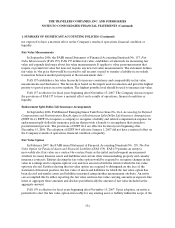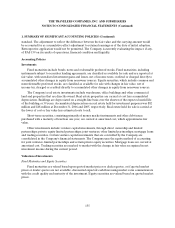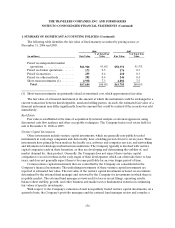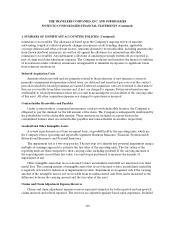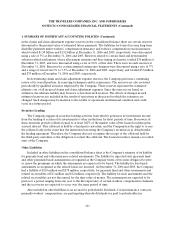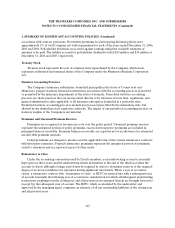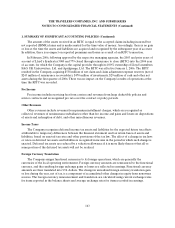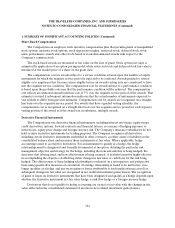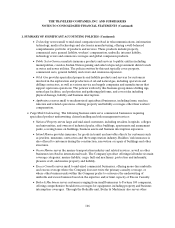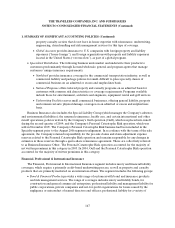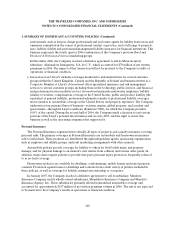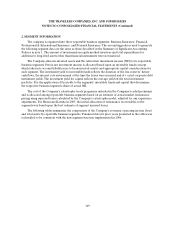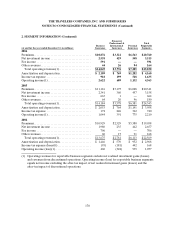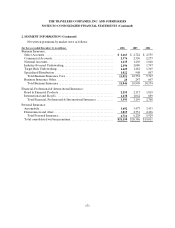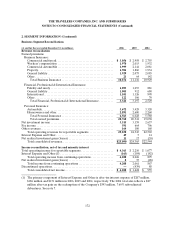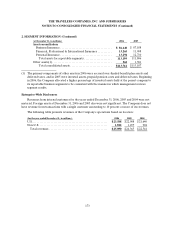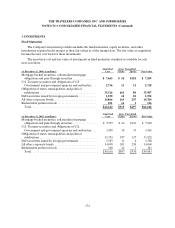Travelers 2006 Annual Report Download - page 176
Download and view the complete annual report
Please find page 176 of the 2006 Travelers annual report below. You can navigate through the pages in the report by either clicking on the pages listed below, or by using the keyword search tool below to find specific information within the annual report.THE TRAVELERS COMPANIES, INC. AND SUBSIDIARIES
NOTES TO CONSOLIDATED FINANCIAL STATEMENTS (Continued)
164
1. SUMMARY OF SIGNIFICANT ACCOUNTING POLICIES (Continued)
Share-Based Compensation
The Company has an employee stock incentive compensation plan that permits grants of nonqualified
stock options, incentive stock options, stock appreciation rights, restricted stock, deferred stock, stock
units, performance awards and other stock-based or stock-denominated awards with respect to the
Company’s common stock.
The stock-based awards are measured at fair value on the date of grant. Stock option fair value is
estimated by application of an option pricing model, while restricted stock and deferred stock fair value is
measured at the market price of a share on the grant date.
The compensation cost for awards subject to a service condition is based upon the number of equity
instruments for which the requisite service period is expected to be rendered. Awards granted to retiree-
eligible or to employees that become retiree-eligible before an awards vesting dateare considered to have
met the requisite service condition. The compensation cost for awards subject to a performance condition
is based upon the probable outcome that the performance condition will be achieved. The compensation
cost reflects an estimated annual forfeiture rate of 5% over the requisite service period of the awards. That
estimate isrevised if subsequent information indicates that the actual number of instruments expected to
vest is likely to differ from previous estimates. Compensation cost for awards are recognized on a straight-
line basis over the requisite service period. For awards that have a graded vesting schedule, the
compensation cost is recognized on a straight-line basis over the requisite service period for each separate
vesting portion of the award as if the award was, in substance, multiple awards.
Derivative Financial Instruments
The Company may use derivative financial instruments, including interest rate swaps, equity swaps,
credit derivatives, options, forward contracts and financial futures, as a means of hedging exposure to
interest rate, equity price change and foreign currency risk. The Company’s insurance subsidiaries do not
hold or issue derivative instruments for tradingpurposes. The Company recognizes all derivatives,
including certain derivative instruments embedded in other contracts, as either assets or liabilities in the
consolidated balance sheet and measures those instruments at fair value. Where applicable, hedge
accounting is used to account for derivatives. For an instrument to qualify as a hedge, the hedge
relationship must be designated and formally documented at inception, detailing the particular risk
management objective andstrategy for the hedge, including the item and risk that is being hedged, the
derivative that is being used, and how effectiveness is being assessed. A derivative must be highly effective
in accomplishing the objective of offsetting either changes in fair value or cash flows for the risk being
hedged. The effectiveness of these hedging relationships is evaluated on a retrospective andprospective
basis using quantitative measures of correlation. If a hedge relationship is found to be ineffective, it no
longer qualifies as a hedge, and any excess gains or losses attributable to such ineffectiveness as well as
subsequent changes in fair value are recognizedin net realized investment gains (losses). The recognition
of gains or losses on derivative instruments that have been designated and qualify as a hedgedepends upon
whether the derivative instrument is a fair value hedge, a cash flow hedge or a foreign currency hedge.
Derivatives that do not qualify for hedge accounting are carried at fair value with the changes in fair
value reflected in the consolidated statement of income in net realized investmentgains (losses).


